Long before Dave Chapman became lead engineer at the Ballard Locks – and years before he earned a degree in mechanical engineering from the University of Washington – he was fascinated by the human-made waterway that connects Lake Washington to Puget Sound.
Chapman says his obsession began when he and his wife didn’t have much money and were living in Seattle in the early 2000s.
“Back then, we had nothing. We couldn’t afford to do anything,” Chapman, who favors trucker caps, puffy coats and sneakers, said as he led me on a tour of the mechanical workings of the Locks, gated chambers that raise and lower boats so they can move through the different water levels of Lake Washington, Lake Union, Salmon Bay and Puget Sound. The Locks also provide flood control for Lake Washington and a fish ladder to assist migrating salmon.
Nearly 50,000 boats each year use the Locks to cross those bodies of water – making them the busiest locks in the United States. “People would come from out of town to visit us, and we’d go to the Locks. I’d tell them: Let me show you this awesome place.”
That awesome place, opened in 1917, attracts more than two million visitors each year, according to the US Army Corps of Engineers. The Ballard Locks, officially known as the Hiram M. Chittenden Locks, consist of two locks: one about 45 meters in length and another 250 meters long. The Army Corps of Engineers owns and operates the Locks and is responsible for keeping them functioning safely. That’s a tall order for infrastructure built over 100 years ago.
In November, the Corps completed a yearlong project to replace the center gate of the large lock.
Replacing a set of iron gates that weigh 240,000 pounds each was not a trivial task. Local marine engineering firm Manson Construction, another longtime Seattle institution since 1905, was awarded an $18 million contract by the Corps to remove the 105-year-old miter gates, rebuild the foundations on which the new gates now rest and set into place two new gates, each weighing 180,000 pounds. The challenging installation took place at night in early November.
“It’s been a super-exciting time to be here,” said Chapman, who’s led the engineering team at the Locks since 2018. “I have a feeling this has been the busiest period of upgrades since this place was built.”
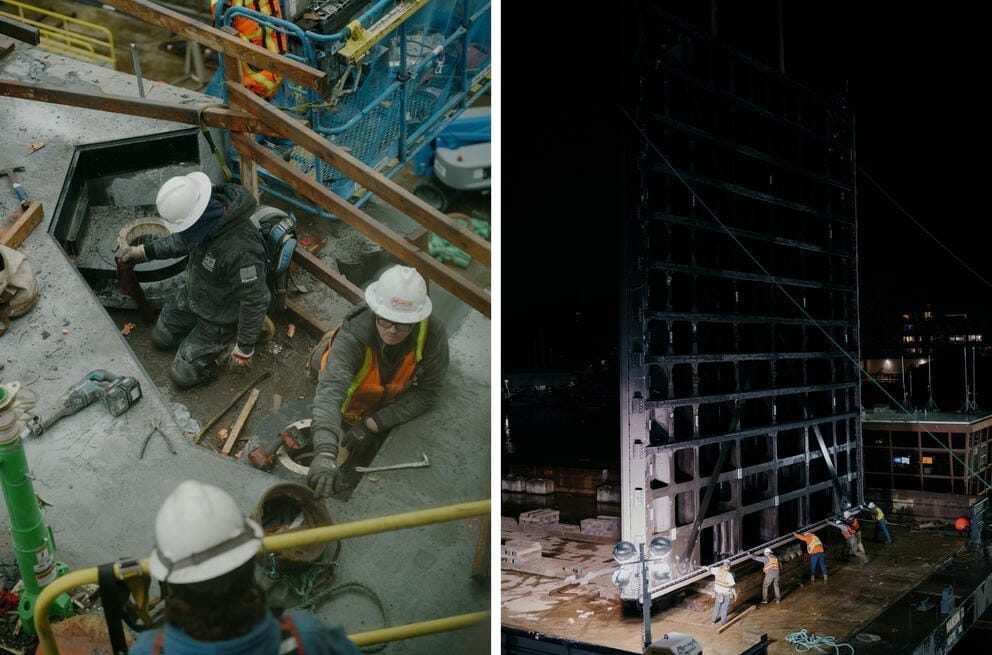
Keeping the antiquated machinery of the Locks up and running is a constant, difficult operation. Imagine that today you drive a Ford Model T– the most popular car on the road when the Locks opened – but in order to keep it running, you need to gradually replace its parts with modern components.
Complicating matters, the Corps of Engineers was committed to minimizing disruption to all the boats that pass through the waterway as well as maintaining public access to one of Seattle’s most popular tourist destinations.
“That’s something that we highlight with every contractor that comes through here: This is not an isolated place,” said Corps project engineer Bradley Ellebracht, who managed the gate replacement. “You want to preserve people’s access. It’s a public site. But on the other hand this is an aging facility, and if we don’t take care of it and make the difficult decisions we need to, this place won’t exist.”
The fact that the Locks serve mostly pleasure boaters provides something of a conundrum in terms of federal funding for maintenance. Most other waterways run by the Corps – such as locks on the Mississippi River or one of its busiest facilities, a lock in Sault Ste. Marie, Michigan, that connects Lake Superior to Lake Huron – are focused on moving commercial cargo. Though the Ballard Locks were originally constructed to facilitate moving timber, today nearly all boat traffic is recreational.
Chapman says that even though about three hundred Alaskan fishing vessels still travel through the Locks to moor in the fresh waters of Ballard to prevent barnacle growth, those ships are empty of cargo. The federal government calculates funding for its locks based solely on cargo tonnage. “We have this unfortunate dilemma, passing the most amount of traffic in the nation with basically the least amount of tonnage,” he said. “So our equipment is super-exercised, but not really well-funded.”
That changed in the past eight years, after Congress allocated money for repairs at the urging of U.S. Rep. Suzan DelBene, D-WA1, who warned in 2017 that the Locks were in danger of falling apart. The $18 million gate replacement was part of that funding package.
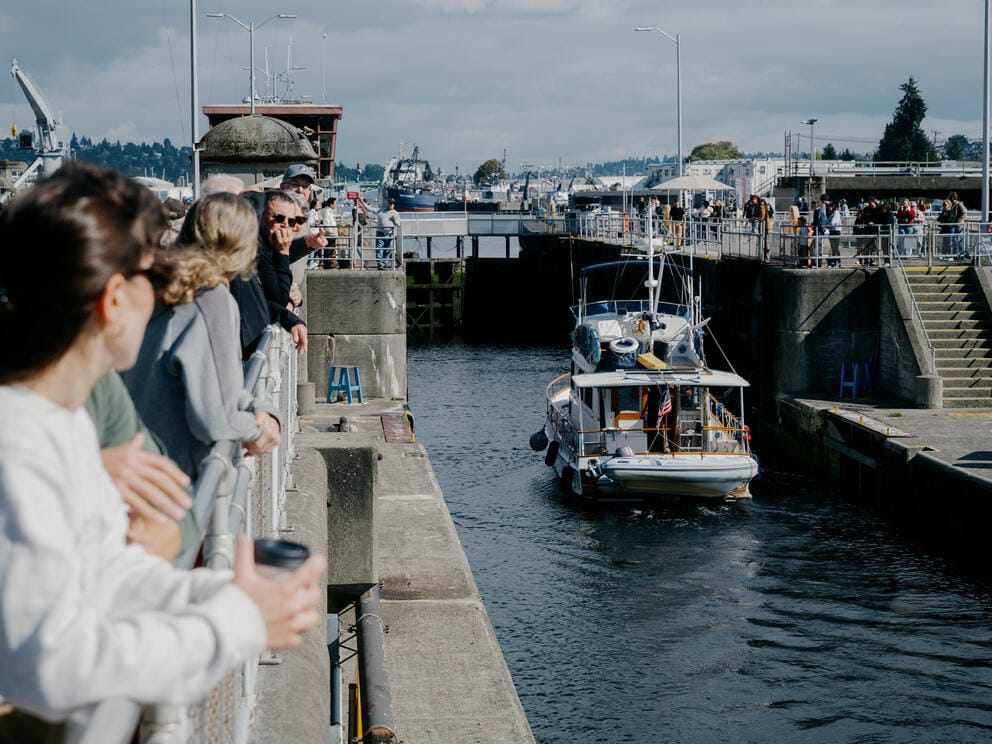
Chapman shows me the inner workings of the Locks, examining massive gears slathered in black grease, rusting pipes over 100 years old, and twisted wiring that dates from the First World War. He says one of the primary functions of the Locks is to keep Lake Washington at a safe level.
He points out that on the October day we were visiting, the lake elevation was at 20.36 feet above sea level, leaving about a foot and a half of wiggle room until the lake is at what he calls “high pool.” The Corps keeps the level of the lake lower in winter to accommodate rainstorms and avoid flooding. Though the lake has never flooded the Locks, Chapman notes that a major storm could potentially shut down or damage the Locks. “At a high lake, those machinery spaces would fill up – dude, they would flood instantly,” he said.
The disaster scenario that keeps Chapman up at night, though, is a major subduction zone earthquake. “Seismic is our number-one failure risk,” Chapman said.

Army Corps disaster planners usually talk about “downstream consequences” of a catastrophic failure at one of their facilities – meaning injuries, deaths and property destruction from the collapse of a dam, for instance. At the Ballard Locks, however, Chapman notes that while there certainly could be deaths on the site during a major earthquake, “here there are zero downstream consequences,” he said, meaning that Puget Sound would absorb a massive outflow of fresh water.
But a sudden lowering of the level of Lake Washington would be disastrous for the two floating bridges that cross it, especially the one that’s soon to have a light-rail line.
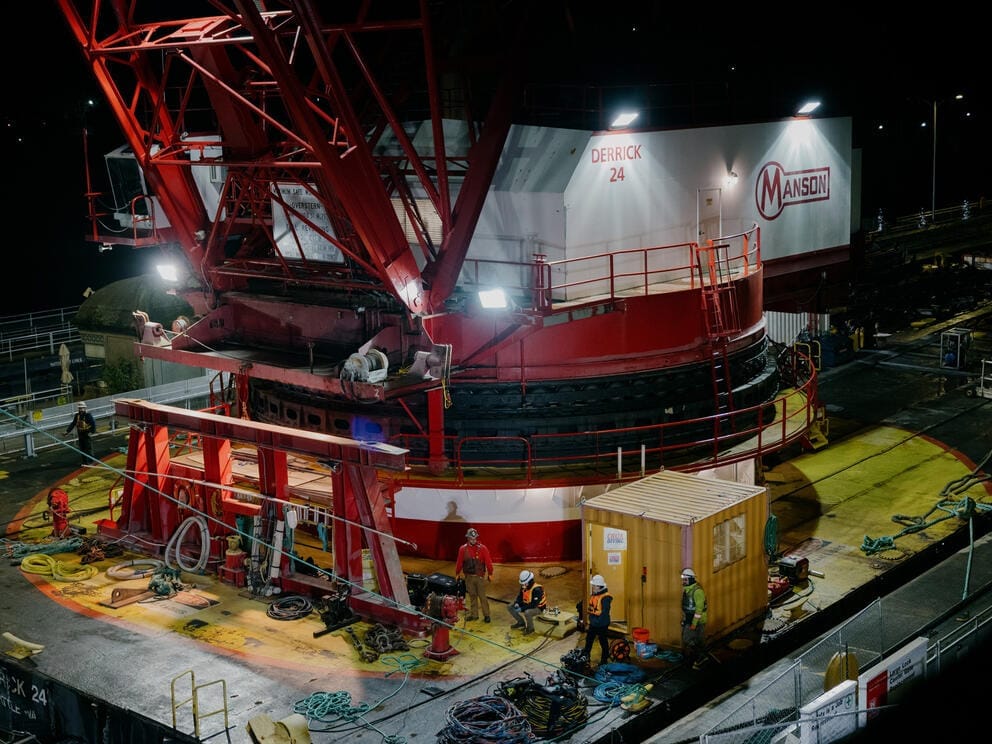
In 2019, the Corps replaced and seismically retrofitted a large crane adjacent to the Locks as a critical part of an emergency plan to protect the water level of Lake Washington if the Locks were ever to fail during an earthquake. Near the huge crane, Chapman points out stacks of metal bulkheads, which, in the event of a disaster, are to be lowered into the water just upstream of the Locks and pulled toward the lake bottom by a cable to create a barrier that will hopefully contain the outflow.
The view of the Locks from the crane is expansive. Chapman sometimes comes up there to sit, since the chair was designed to be especially comfortable for whoever has to work long hours to save Lake Washington. “It’s the best seat in the house,” he says.
A transportation route
Before white settlers arrived in the Pacific Northwest, Native people, including the Duwamish, had used Lake Washington, Lake Union and Salmon Bay as a transportation route for thousands of years. As early as 1854, settler Thomas Mercer proposed connecting Lake Washington and Puget Sound via Lake Union. Various private efforts to dig a connection came to nothing, and for a while attention shifted to north of Beacon Hill (the valley where Dearborn Way now exists was once partially excavated for a canal project that was later abandoned).
In 1906, Hiram M. Chittenden, an engineer who was second in his class at West Point and who had designed the road system in Yellowstone National Park, was tasked by the Corps of Engineers with designing a waterway that would link Puget Sound and Lake Union. According to Susan Connole, a longtime volunteer with Friends of the Ballard Locks, Chittenden made some crucial decisions that contributed to the Locks’ longevity and effectiveness.
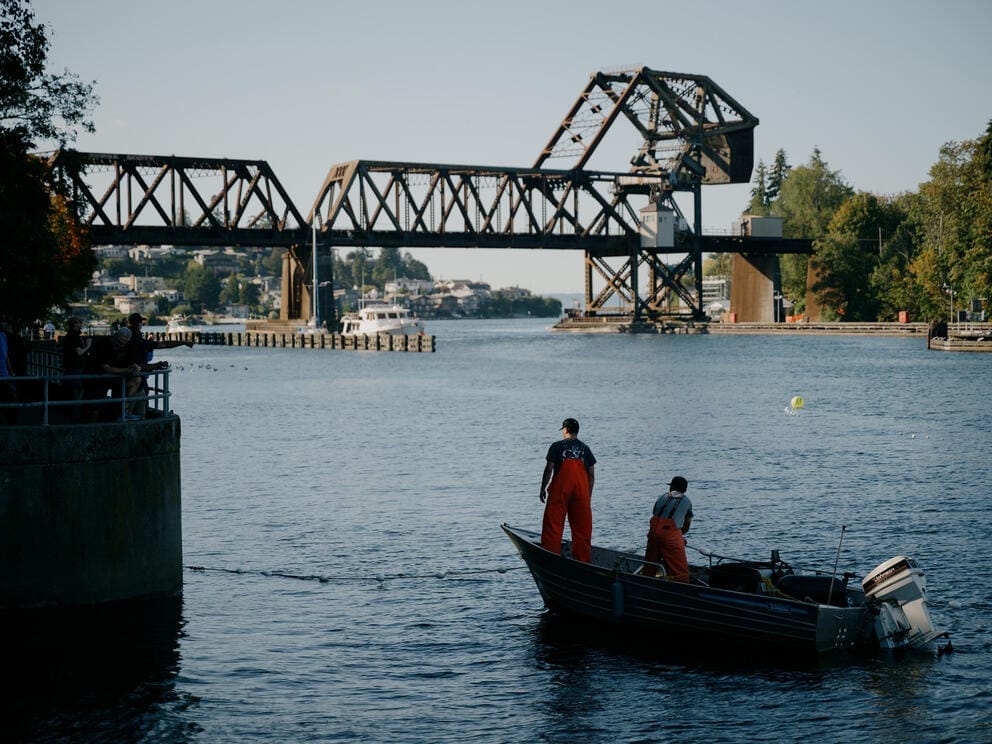
Originally, the Locks were to be built right at the edge of Lake Union, but according to Connole, Chittenden told his planners otherwise. “He said: No, we’re going to move the locks out to the saltwater side of Salmon Bay and then raise Salmon Bay to be a freshwater harbor.” This is how Salmon Bay became, to this day, a popular site to moor and outfit ships.
In an early design, the Locks were to be built of wood, but Chittenden insisted on using concrete. Much of that is still in place today. And instead of one single lock, Chittenden proposed two – one large and one smaller. The work to complete the Locks and dig the Fremont and Montlake cuts took a total of seven years, and Chittenden, who suffered from poor health, had to retire from the Corps of Engineers before the Locks were completed in 1916. The waterway formally opened in 1917.
Chittenden’s design also included something novel at the time – a fish ladder to allow migrating salmon to spawn in the lake. That ladder was given a substantial upgrade in 1976 that includes 21 weirs that make it easier for salmon to successfully jump each falls. It also features the beloved glass viewing windows that allow visitors to observe salmon on their homeward journey.
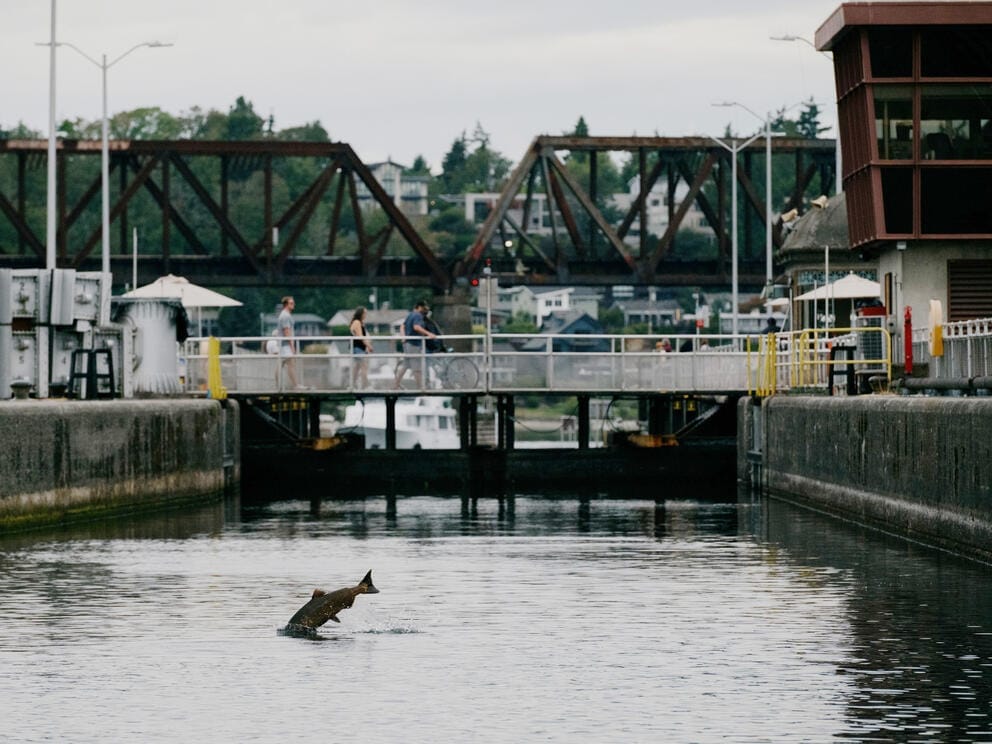
Though the Locks were successful early on in moving timber from mills on Lake Washington to Puget Sound and ports around the world, the impact on Indigenous people was profoundly negative. Before the Locks opened, the Sammamish River flowed into Lake Washington, and the lake’s southern outlet was called the Black River, an important waterway for fishing and canoe travel for the Duwamish people.
Having been pushed out of their traditional villages on the Duwamish River by settlers building the new city, the Duwamish established a sizable new village on the Black River. But upon the completion of the Locks, the average water level of Lake Washington dropped nearly nine feet, and as a result, the Black River dried up and the Cedar River reversed direction. Water flow into the Duwamish River decreased significantly.
The village had to be abandoned, and once-productive salmon runs in the Duwamish dwindled.
“Native people completely lost their subsistence with the drying up of the Black River,” Connole says.
Future construction
Chapman, with boisterous enthusiasm, takes me underground beneath the gorgeous administration building, with its oak paneling, oval stained glass skylight and marble floors. Descending, we pass retired electrical panels and old monitor dials straight out of a steampunk movie. “None of this stuff works, but it's cool to look at,” Chapman says.
Down deeper, we pass through a set of chambers with metal grate walkways that would make a great setting for the final scene of an action movie. Some of the original huge pumps here still function for de-watering the Locks, but many of the pipes have been replaced or repaired.
Pointing to one pipe some 100 years old, Chapman recalled the time it cracked and a fish popped out.
“That was something else,” he said.
Deeper still, we pass into a tunnel directly below the Locks, where a tangle of electrical cables brings power to the antiquated machinery. Water drips ominously from the ceiling onto a mass of black cables like some gargantuan version of early-20th-century knob and tube wiring still found in a few Seattle bungalows.
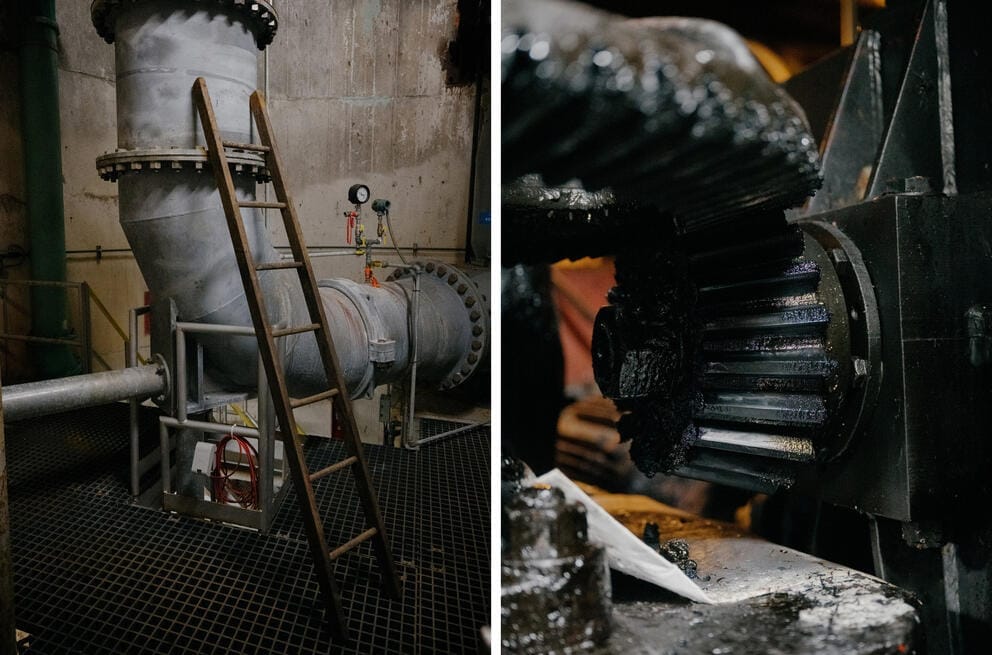
“The next big project that we have queued up,” Chapman said, “is our decrepit electrical distribution system. Currently we distribute on an obscure, ungrounded 2,400 volts, in a delta configuration.” It’s a system hardly used anywhere in the world anymore, he noted.
“As the transformers go out,” Chapman says, “we can’t buy a new one. It’s not like they’re on the shelf somewhere.”
The original iron gates on the large lock, which were removed in October 2023, were hollow, Chapman says. During the early years of maintenance, crews would remove the iron gates, which were buoyant, and “float them down to the beach just beyond the bridge, and at low tide, land them on the beach,” he marveled. “Then they’d mop tar all over them. It was so crazy.”
Manson Construction, which specializes in large-scale marine projects including the rebuild of the Seattle waterfront seawall and the 520 bridge expansion, not only removed those old gates, but also forged and welded together the new set of steel miter gates that would replace them. The contractor barged both of the new 230-ton gates to Seattle in time for installation on Election Day. That operation involved a massive barge crane, several divers and two remote underwater cameras to ensure that the gates were lowered into place precisely onto the pintle – a large steel ball that each gate hinges on.
Kelli Struett, Manson’s project manager for the gate replacement, said the process of setting those gates into place was fascinating but perhaps a little anticlimactic for those who came to watch. “Most people think these heavy lifts are really exciting, and they want to be there for them – but they’re slow,” Struett said. Manson placed them in the middle of the night to ensure visitors didn’t get in the way. “You’re just moving barely anything at a time, bumping the controls very slightly and getting it all lined up. They slowly set it down and it went in perfectly,” she said.
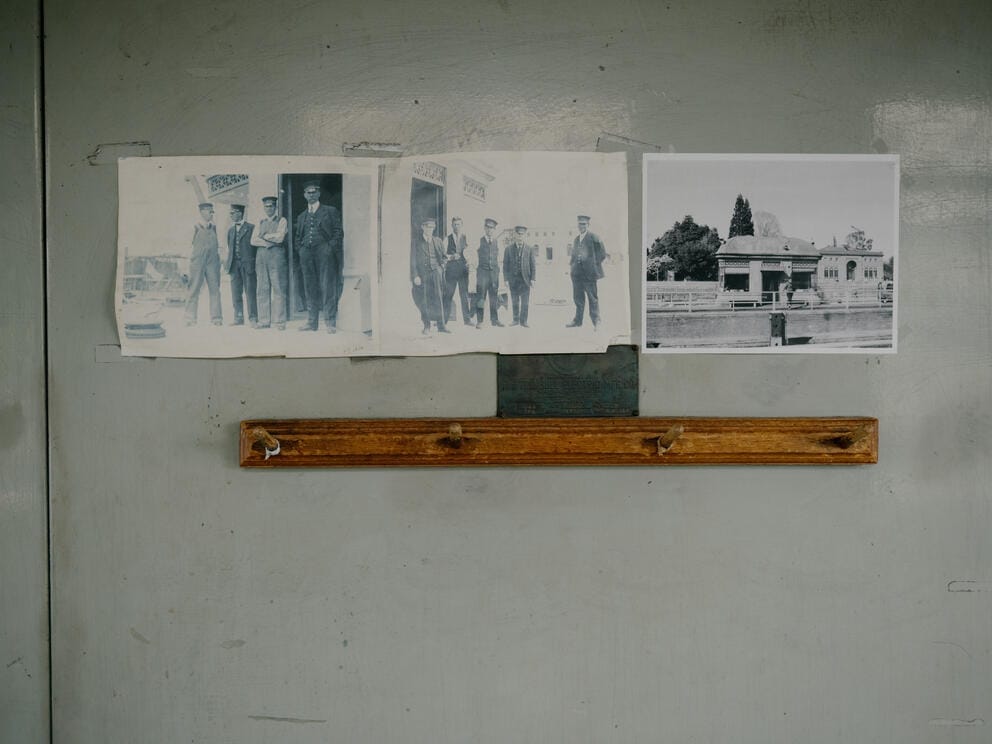
Ellebracht says that during recent demolition of original concrete, a crew discovered old railroad tracks used as reinforcement. “You just don’t know what you’ll find,” he said. “It’s never boring.”
The new gates, Chapman said, employ new technology that’s never been used in the United States. On what’s known as the quoin block, where the steel gate meets the concrete, the Corps is using fiber reinforced polymer (FBR) and a series of discontinuous quoins to spread out the immense weight of the water held in the large lock.
“The water pressure on these gates, the force that gets blasted into the walls, is unbelievable,” Chapman said. The new approach, which also uses a gigantic rubber seal between the two steel gates, brings 21st-century technology to the aging structure. “It’s going to be exciting to see how well that works,” he said.
The man who used to ride his bike down to the locks and spend hours exploring the place long before he was an engineer is grateful to have such a quirky, fascinating job, making sure the Ballard Locks keep working for another hundred years. “Never in a million years did I think I’d be working at a place as cool as this.”


